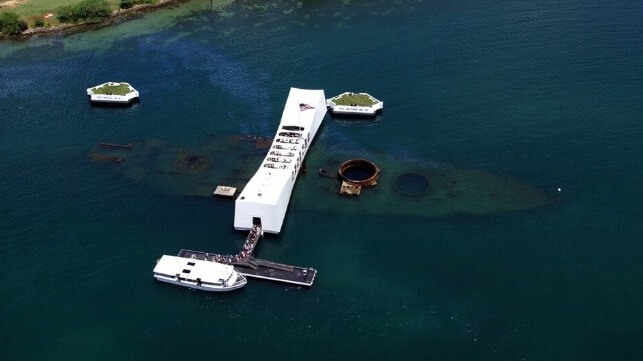Study: USS Arizona is Still Slowly Releasing Fuel Oil
The "tears of the Arizona" provide researchers with new data

The wreck of the U.S battleship USS Arizona could see its status elevated from a solemn memorial to a ‘living laboratory’ after it emerged that oil continues to leak from the ship more than 80 years after its sinking at Pearl Harbor.
Analyzing oil samples collected from multiple points on the World War II warship, results show that oil is still seeping from the wreck. The researchers led by the University of Houston and Woods Hole Oceanographic Institution (WHOI) used advanced molecular fingerprinting techniques to analyze the samples collected by the National Park Service (NPS) in 2016 and 2018. Results have confirmed the oil is heavy fuel oil refined from California crude, consistent with U.S. Navy fueling practices in the early 1940s.
Despite the sunken warship being underwater for decades, the oil retains high concentrations of polycyclic aromatic hydrocarbons (PAHs), compounds known for their persistence and potential toxicity. The researchers have published their findings in the Marine Pollution Bulletin.
The findings underscore the fact that apart from holding the status of being a solemn war grave, Arizona's wreck has the potential to become a ‘living laboratory’ for understanding the long-term fate of petroleum trapped in shipwrecks. The wreck has an estimated 600,000 gallons of oil still on board, and has a need for ongoing monitoring.
Oil is not leaking at a highly concerning rate from the Arizona wreck, researchers say. And while it does contain PAHs, not all of them are highly toxic. Besides, although the oil comes from the same shipping fuel, it changes chemically before it escapes. As it moves through the maze of wreckage, it encounters varying oxygen levels, water flow, and microbial activity, shaping the oil's chemistry and giving each leak a unique fingerprint.
The U.S. Navy is in the process of removing two aging mooring platforms that were welded onto the wreck in order to preserve her memories and hundreds of servicemen who perished in the aftermath of the Pearl Harbor attacks. The Arizona Memorial honors 1,177 crewmen who died in the attack, among them more than 900 sailors and marines.
“As one of America's most hallowed war graves and the site of tragedy and sacrifice at the outset of a global conflict for our country, the site demands the best and most considered science we can muster,” said David Conlin, a marine archaeologist with NPS. “The work we have completed is groundbreaking in its implications and also its respectful, non-intrusive approach to data gathering.”
The researchers contend that the findings have global significance owing to the fact that thousands of WWII-era wrecks, containing millions of gallons of unrecovered fuel, rest on ocean floors worldwide, with many being in nearshore environments. Essentially, the Arizona wreck offers a unique insight into how oil behaves over decades in low-oxygen, submerged conditions, something that can greatly inform modern spill response strategies and environmental risk assessments.
The team highlights that the chemical composition of the oil varies depending on the leak location, reflecting differing degrees of natural “weathering” processes, including microbial biodegradation and dissolution. While lighter compounds are gradually breaking down, key petroleum biomarkers remain intact, allowing scientists to trace the oil's source and behavior over time.
Chris Reddy, marine chemist at WHOI, contends that the study offers valuable insights that strengthen preparedness and planning for future operations at other shipwrecks. “When deciding whether to remove oil from a shipwreck, we weigh the risk of a potential spill against the danger of disturbing the site itself,” he noted.
He added that factors like the amount of oil remaining, the rate of leakage, the local ecosystem's sensitivity, and the cultural or historical value of the wreck all play a role. When all factors are considered, sometimes the best choice is careful monitoring rather than intervention.
